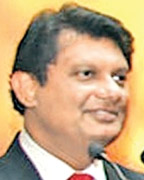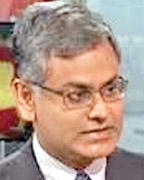|
'Invest Sri Lanka' forum in London:
Platform to ensure steady flow of investments
By Shirajiv Sirimane
The world has being talking about economic recession in several
developed countries which had a negative impact on the world economy.

Transhipment cargo at the Hambantota port |

The high-end shopping mall at the racecourse
|

A model of the apartments to be built at Slave Island |
 |
| Colombo in the
future |
 |
Central Bank
Governor
Ajit Nivard Cabraal |
 |
SEC Chairman
Dr. Nalaka Godahewa |
 |
CSE Chairman
Krishan Balendra |
 |
High
Commissioner
Dr. Chris Nonis |
However, the global recession did not have any negative impact on the
local economy mainly due to political stability and far thinking
measures taken in Sri Lanka. The country continued to reap benefits from
exports and foreign exchange remittances.
A new meaning to economic stability to Sri Lanka has been given by
recording an average annual economic growth of 7.5 percent over the past
four years.
Annual economic growth rate from 1951 to 1977 was at 3.7 percent
while this increased to 4.8% from 1978 to 2005. This figure increased to
6.7% from 2006-2013.
The GDP which was at US$ 24 billion in 2005 increased to 67 billion
in 2013. The Average Annual Increase in Per Capita GDP from 1978 to 2005
which was at 5.8% increased to 13.1% in the 2006-2013 period.
The unemployment rate, which is a key factor in determining economic
stability, has moderated and stabilised below 5% over the past four
years.
Openness
Lankan merchandise exports and imports over the past eight years too
have increased reflecting the country's growing economic activity and
increased openness. Exports last year stood at US$ 10,394 million while
imports were at US$ 18,003 million. In 2005, exports were at US$ 6,347
million while imports stood at US$ 8,863 million.
The importance of services exports has also been rising while
workers' remittances have increased significantly. In 2013 Service
Exports stood at US$ 4,685 million while workers' remittances was at US$
6,407 million.
The external current account has been improving while allowing
greater trade openness. The current Account Deficit in 2013 was 3.9% of
GDP. The Balance of Payments too is now in positive territory on a
consistent basis with a BOP Surplus of US$ 985.4 million.
Gross Official Reserves (US$ 7.5 billion) have reached unprecedented
levels and 'Months of Imports' have also recorded comfortable levels in
recent times. The exchange rate has been relatively stable, thereby
supporting economic and price stability.
A medium term macroeconomic framework is envisaged to take the
economy beyond a per capita income of US$ 4,000. The projected GDP per
capita in 2016 is US$ 4,825 million.
Economic outlook
The Sri Lankan economy envisages a growth of about 8% per annum on a
sustainable basis and an investment level of about 33% of GDP is
targeted.
Sri Lanka has already laid the platform to ensure a steady flow of
investment and an 'Invest Sri Lanka - Investor Forum' was held on Friday
at the Savoy Hotel, London.
The Colombo Stock Exchange (CSE) and the Securities and Exchange
Commission of Sri Lanka (SEC) hosted this event which was organised with
the London Stock Exchange and Bloomberg.
The keynote presentation at this event on the subject Economic
Outlook in Sri Lanka was made by Central Bank Governor Ajith Nivard
Cabrral. The Chief Executive Officer, London Stock Exchange plc,
Alexander Justham and Sri Lankan High Commissioner to the United
Kingdom, Dr. Chris Nonis also spoke.
 |
| An artist's
impression of the Viharamahadevi Park |
 |
| The
Independence Square |
The forum saw an unprecedented response from institutional investors
with over 100 participants.
Global Prosperity Index
A panel discussion was also conducted at the conclusion of the
presentations. The panelists included Governor Cabraal, Sri Lankan High
Commissioner Dr. Chris Nonis, SEC Chairman Dr. Nalaka Godahewa, CSE
Chairman Krishan Balendra and CSE, CEO Rajeeva Bandaranaike.
Governor Cabraal said that prosperity, as measured by the Global
Prosperity Index and the HDI has improved.
"Sri Lanka was ranked 60th in the world in the Global Prosperity
Index and this was the highest ranked for South Asia. Sri Lanka was also
ranked 92 in the world in the Human Development Index," he said.
Government continued with the mega-scale infrastructure development,
which has improved the country's productive capacity significantly.
"The 5+1 hub strategy introduced under Mahinda Chintana has gathered
momentum for inclusive and sustainable growth in Sri Lanka. "The
activities relating to all these hubs will spearhead the transformation
of the country into a commercial and business hub," Cabraal said.
"That will probably encourage the relocation of many regional
operating headquarters and regional offices of international
establishments," he said.
High mobile penetration
The declaration of Hambantota and Colombo South ports as free ports
is also expected to attract significant private sector investments. Fast
tracked expressway and road development projects have reduced
transportation costs and enhanced access to markets through improvements
in urban-rural links.
Healthy pace of growth in the telecommunications sector has resulted
in high mobile penetration, rapidly growing internet penetration and
increased potential in mobile related and e-commerce activities.
Public utilities are being developed to cater to the emerging world
class city of Colombo.
Productive and skilled labour force with large pools of professionals
as a result of government's commitment to free education and health will
create a knowledge-driven economy.
The per capita income of Sri Lanka which is now at US $ 4,085 is
expected to reach the US $ 4,000 mark soon. The governor predicted that
by 2016, Sri Lanka will graduate to the 'Upper Middle Income' category
as per international classification.
"The Central Bank will also ensure that its future macroeconomic
policies will be fashioned so that the country will avoid the 'Middle
Income Trap'," he said. |

